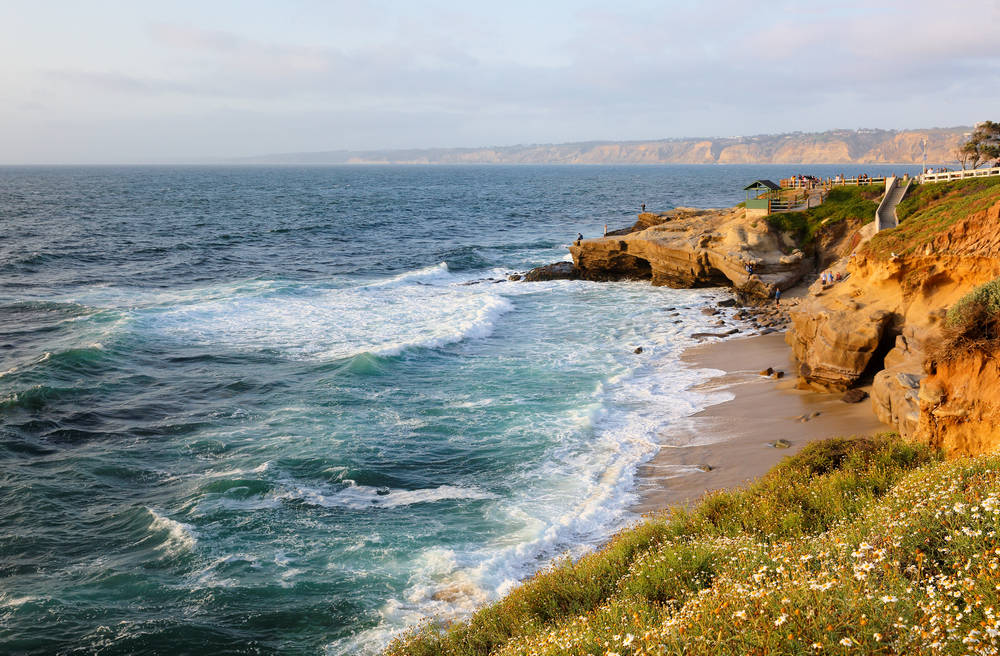La Jolla Cove is San Diego’s most famous dive site! It’s one of the few areas in California where you can find giant kelp beds, rocky reefs, and sea caves. Plus, it’s one of the best places in California to dive with sea lions. This article is a detailed description of La Jolla Cove: A Guide for Scuba Divers.
La Jolla Cove’s Marine Conservation
Decades of conservation efforts have made La Jolla Cove a dive site filled with marine life. The area is a part of the Matlahuayl State Marine Reserve, a protected area encompassing the waters in and around La Jolla Cove, making it like an underwater state park! Within the reserve boundaries, no one can hunt or catch marine life. Commercial, recreational, and spearhead fishing are not allowed. It is also prohibited for visitors to take “geological items,” like shells and rocks, from the cove. Matlahuayl is one of three marine sanctuaries in La Jolla. There are two conservation areas to the north and south, and together they create a safe passageway for marine life to flow more naturally.
La Jolla Cove Dive Features
What kind of habitats can you expect to see on your dive through La Jolla Cove? The cove features four different main areas: the seagrass meadow, the kelp beds, the reefs, and the sea caves.
Seagrass Meadow
In the shallowest part of La Jolla Cove, you’ll find the seagrass meadow full of beds of surfgrass and eelgrass. Surfgrass clings to underwater rocks, and eelgrass grows in the sand or mud. Watching the seagrasses billow back and forth in the surf is incredible. When diving in the seagrass meadow, look out for invertebrates like nudibranchs and sea stars. You might also come across baby and juvenile fish that swim and feed here until they grow enough to survive in larger reefs.
Kelp Beds
Most divers come to California for the kelp forests. An expansive bed of giant kelp creates The La Jolla Kelp Forest. The giant kelp grows up to the surface from the rocky bottom, forming an underwater forest to swim through. You can find plenty of fish, sharks, and pinnipeds in the kelp forest, but the giant kelp is the real star! The kelp beds feel enormous and otherworldly because of the dazzling interplay of light and shadow. The kelp bed in La Jolla is among the largest and healthiest in Southern California.
Reefs
La Jolla Cove has shallow rock reefs covered in algae and seagrass. You can find a variety of fish and invertebrates hiding in the crevices of the rocks. You can also find eels, stingrays, and horn sharks swimming around the reefs.
Sea Caves
Scuba diving is the best way to explore the “Seven Caves” in La Jolla. They can be seen on a kayak or snorkeling tour but are best seen when diving. On calm days, divers can explore swim-throughs that barrel through the rock. The caves are mostly shallow and feature big, open-air chambers where you can surface. You might find yourself inside a spacious cavern with sea lion pups swimming alongside you. If you’re diving in this area for the first time, make sure you’re diving with a guide.
La Jolla Cove Marine Life
The cove provides food and shelter for various underwater creatures, including fish, mammals, and invertebrates. Occasionally you might spot a visitor from deeper waters, like the broadnose sevengill shark.
Here’s a brief list of the most popular and commonly seen wildlife in La Jolla Cove:
Fish
- Garibaldi
- California Sheephead
- Kelp Bass
- Opaleye
- Sargo
- Surfperch
- Blacksmith
- Señorita
- California Moray Eel
Sharks and Rays
- Horn Shark
- Leopard Shark
- Broadnose Sevengill Shark
- Round Stingray
- Banded Guitarfish
Marine Mammals
- California Sea Lion
- Harbor Seal
- Green Sea Turtle
Marine Birds
- Brown Pelican
- Brandt’s Cormorant
Invertebrates
- California Spiny Lobster
- Sheep Crab
- Norris’s Top Snail (“kelp snail”)
- Ochre Sea Star
Algae and Seagrass
- Braided Hair Algae
- Giant Kelp
- Feather Boa Kelp
- Surfgrass
- Eelgrass
Diving at La Jolla Cove
Diving in California is a different kind of diving – it is not the same as the tropical diving you might have done on your Caribbean vacation or South Pacific adventure. California has a “temperate water” ecosystem, which means the water is cooler and visibility is often less than 30 feet. Even so, California diving is amazing! You can see animals and habitats in California that you wouldn’t see anywhere else. If this is your first time diving in California, you’ll want to know some key things before you start:
Water Temperature
California is considered “cold water diving,” but everyone has a different definition of “cold.” On average, the water temperature in La Jolla Cove is 63°F, and throughout the year, the temperature ranges from 53°F/12°C to 66°F/19°C. During the summer months, the water can reach 78° F/25°C.
The water is warmest in the Fall, from September through November, and the water is coldest in the winter and early spring. If you’re nervous about diving in cold water, consider visiting during the summer when the air temperature is warm. The water will still be cool, but the warm air will be more comfortable before and after the dive. Wearing a 7mm wetsuit with a hood and gloves is typically for California divers, but some San Diego divers wear drysuits.
Visibility
A few things can reduce the visibility during your dive at La Jolla Cove. On average, the visibility ranges from 10 to 20 feet; on its best days 30 to 40 feet. The cold water in San Diego is full of nutrients and microorganisms that cloud up the water and limit visibility. Strong surf can also cause poor visibility by stirring up sand and silt. Sometimes visibility can change throughout your dive. One minute you could have 20-foot visibility, and the next, you might have 10 feet or less. Guided dives are suggested when exploring La Jolla Cove for the first time to help you navigate the unpredictable visibility and underwater landscape.
Surf Conditions
There’s often light to moderate surge at La Jolla Cove. You should take caution if you’ve never dived here before. because of the unseen potential risks. There are rock outcroppings hidden just inches beneath the water, and if you’re not careful, then a large swell could push you against or on top of them. The sea caves can also be dangerous if you have never dived them before, especially if there is a moderate surge. Always consider diving with a qualified guide if it’s your first time exploring La Jolla Cove.
Dive with San Diego Scuba Guide!
We hope you enjoyed reading La Jolla Cove: A Guide for Scuba Divers and gained some insights for your next dive. At San Diego Scuba Guide, we provide day and night guided dives in La Jolla Cove. Our experienced guides will ensure that you have Southern California’s best shore diving experience. We’ll take you safely through the cove’s four habitats and help you spot the marine life, visible or hiding! Call or text (858) 397-8213 or visit our website to book your next dive!


